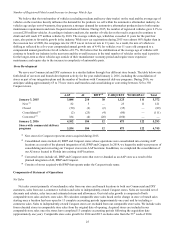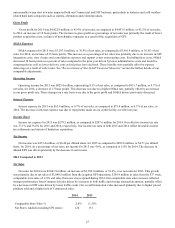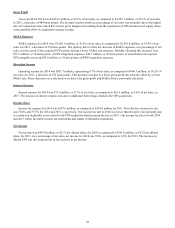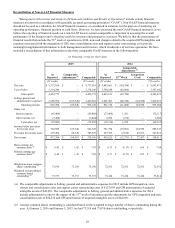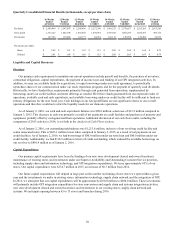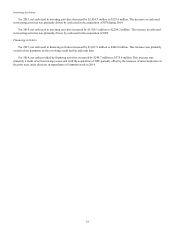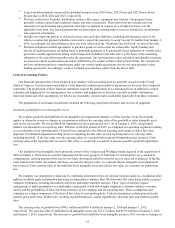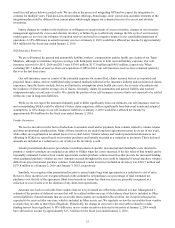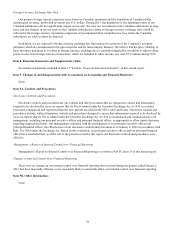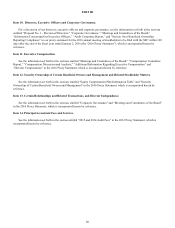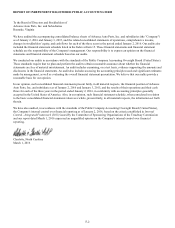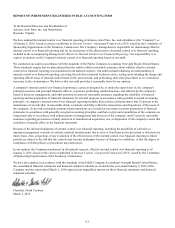Advance Auto Parts 2015 Annual Report Download - page 48
Download and view the complete annual report
Please find page 48 of the 2015 Advance Auto Parts annual report below. You can navigate through the pages in the report by either clicking on the pages listed below, or by using the keyword search tool below to find specific information within the annual report.35
(1) Long-term debt primarily represents the principal amount of our 2020 Notes, 2022 Notes and 2023 Notes, which
become due in 2020, 2022 and 2023, respectively.
(2) We lease certain store locations, distribution centers, office space, equipment and vehicles. Our property leases
generally contain renewal and escalation clauses and other concessions. These provisions are considered in our
calculation of our minimum lease payments which are recognized as expense on a straight-line basis over the
applicable lease term. Any lease payments that are based upon an existing index or rate are included in our minimum
lease payment calculations.
(3) Includes the long-term portion of deferred income taxes and other liabilities, including self-insurance reserves for
which no contractual payment schedule exists and we expect the payments to occur beyond 12 months from January 2,
2016. Accordingly, the related balances have not been reflected in the “Payments Due by Period” section of the table.
(4) Purchase obligations include agreements to purchase goods or services that are enforceable, legally binding and
specify all significant terms, including fixed or minimum quantities to be purchased; fixed, minimum or variable price
provisions; and the approximate timing of the transaction. Included in the table above is the lesser of the remaining
obligation or the cancellation penalty under the agreement. Our open purchase orders related to merchandise inventory
are based on current operational needs and are fulfilled by our vendors within a short period of time. We currently do
not have minimum purchase commitments under our vendor supply agreements nor are our open purchase orders
binding agreements. Accordingly, we have excluded open purchase orders from the above table.
Critical Accounting Policies
Our financial statements have been prepared in accordance with accounting policies generally accepted in the United
States of America. Our discussion and analysis of the financial condition and results of operations are based on these financial
statements. The preparation of these financial statements requires the application of accounting policies in addition to certain
estimates and judgments by our management. Our estimates and judgments are based on currently available information,
historical results and other assumptions we believe are reasonable. Actual results could differ materially from these estimates.
The preparation of our financial statements included the following significant estimates and exercise of judgment.
Goodwill and Indefinite-Lived Intangible Assets
We evaluate goodwill and indefinite-lived intangibles for impairment annually as of the first day of our fiscal fourth
quarter or whenever events or changes in circumstances indicate the carrying value of the goodwill or other intangible asset
may not be recoverable. We test goodwill for impairment at the reporting unit level. As of January 2, 2016, our goodwill
balance was allocated to six reporting units. Effective in the first quarter of 2015, we realigned our operating segments resulting
in a reevaluation of our reporting units. Goodwill was reassigned to the affected reporting units using a relative fair value
approach. Our detailed impairment testing involves comparing the fair value of each reporting unit to its carrying value,
including goodwill. If the fair value exceeds carrying value, we conclude that no goodwill impairment has occurred. If the
carrying value of the reporting unit exceeds its fair value, a second step is required to measure possible goodwill impairment
loss.
Our indefinite-lived intangible assets primarily consist of the Carquest and Worldpac brands acquired in the acquisition of
GPI on January 2, 2014 and are tested for impairment at the asset group level. Indefinite-lived intangibles are evaluated by
comparing the carrying amount of the asset to the future discounted cash flows that the asset is expected to generate. If the fair
value based on the future discounted cash flows exceeds the carrying value, we conclude that no intangible asset impairment
has occurred. If the carrying value of the indefinite-lived intangible asset exceeds the fair value, we recognize an impairment
loss.
We complete our impairment evaluations by combining information from our internal valuation analyses, considering other
publicly available market information and using an independent valuation firm. We determine fair value using widely accepted
valuation techniques, including discounted cash flows and market multiple analyses. These types of analyses require
management to make assumptions as a marketplace participant would and to apply judgment to estimate industry economic
factors and the profitability of future business strategies of our company and our reporting units. These assumptions and
estimates are a major component of the derived fair value of our reporting units. Critical assumptions include projected sales
growth, gross profit rates, SG&A rates, working capital fluctuations, capital expenditures, discount rates and terminal growth
rates.
The carrying value of goodwill was $989.5 million and $995.4 million at January 2, 2016 and January 3, 2015,
respectively. The carrying value of indefinite-lived intangible assets was $334.7 million and $339.4 million at January 2, 2016
and January 3, 2015, respectively. The decrease to goodwill and indefinite-lived intangible assets in 2015 was due to changes in


